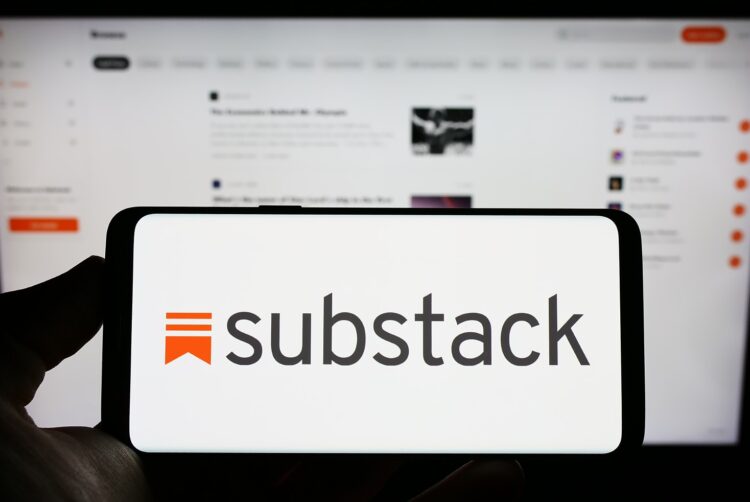Substack is warming to advertising. Will brands warm to Substack?

Substack is reportedly warming to advertising following a new $100m funding round.
The latest group of investors in the publishing platform include private equity investor The Chernin Group, tech investment company Bond, sports agency Klutch Sports Group, venture capital fund Andreessen Horowitz and Skims co-founder Jens Grede, according to The New York Times.
The funding valued Substack’s business at $1.1bn, up from $650m in 2021.
Currently, the platform’s business model is based wholly around subscriptions; Substack takes a 10% cut of revenue from creators who charge for access to their newsletters, blogs and podcasts.
CEO Hamish McKenzie has previously criticised advertising models as “busted”, but today he sings a different tune, suggesting an embrace of advertising amounts to “a recognition of new possibilities”.
Chernin co-founder Mike Kerns called it “inevitable” that the company will embrace an advertising model, given many influential creators operating on the platform have indicated to leadership that “they want Substack to support advertising”.
News, analysis, comment and community — Join The Media Leader
Analysis: ‘Natural evolution’ of business model
Substack counts a number of leading journalists and writers among its users, many of whom have been recently let go from positions at more traditional publishers and news outlets.
According to Press Gazette, as of the beginning of the 2025, there were at least 52 accounts on Substack generating at least $500,000 per year in subscription revenue.
Notable accounts include ex-MSNBC presenter Mehdi Hasan’s Zeteo, former New York Times columnist Bari Weiss’ The Free Press, ex-Washington Post columnist Jennifer Rubin’s The Contrarian, historian Heather Cox Richardson’s Letters from an American and novelist George Saunders’ Story Club.
While Substack was originally billed as a writer’s haven, it has added features over time that have made it more like other multimedia platforms, including podcasts, live streaming and microblogging, as well as short- and long-form video hosting and monetisation.
As it has subsequently attracted more talent from the wider creator economy, it’s little surprise that Substack would move into advertising to grow both its own business and the opportunity for users.
“Substack’s move towards advertising feels like a natural evolution,” Matt Wilké, head of programmatic and digital partnerships at independent agency Mediaplus UK, told The Media Leader. “The subscription model gave it integrity, but diversified revenue was always going to be part of the next chapter.”
Wilké suggested that the platform’s shift to advertising could be compelling for advertisers given it plays host to highly engaged, self-selecting audiences — “the kind of intentional media consumption that’s becoming harder to find for media planners”.
The brand-safety question
Some agencies have sought to increasingly recommend news publishing to clients on that precise basis.
Stagwell, for example, launched a private marketplace recently aimed at making it easier for advertisers to access and target what it has categorised as “news junkies” — or those who follow news “very closely”.
HarrisX, Stagwell’s research arm, found that such consumers generally have a higher purchase intent than the general population, suggesting that those well-attuned to news provide ample opportunity for brands.
While traditional publishers have been the target of such initiatives, as talent has increasingly moved to independent publishing on platforms like Substack, advertisers could patronise their work in ways familiar to how they interact with the creator economy.
“If it can introduce advertising in a way that complements the writer-reader relationship through thoughtful partnerships, contextual placements or formats that fit the tone of the platform, it could offer something valuable,” Wilké observed. “Not just more inventory, but a different quality of attention in an era where attention as a metric is all the rage.”
That said, while titles on Substack have gained popularity, their relative lack of professional editorial oversight and resourced staff have led critics to warn of bias — and this could create a concern for marketers highly sensitive to brand safety.
As marketers from Luxottica and Reckitt admitted at Cannes, they are still avoiding advertising against “hard news” over concerns that their brand could show up “next to something that is not safe for our brand affinity”.
Substack has itself been criticised for failing to moderate titles on its platform for hate speech, with McKenzie previously declining to remove or demonetise pro-Nazi content found on Substack.
Should it lean in to advertising, Substack would need to tackle not only perceived but unfounded concerns over brand safety, but also the legitimate concerns that brands have over ad adjacency in social platforms.
Bountiful Cow study finds all news is brand-safe, with ‘unsafe’ inventory most effective




